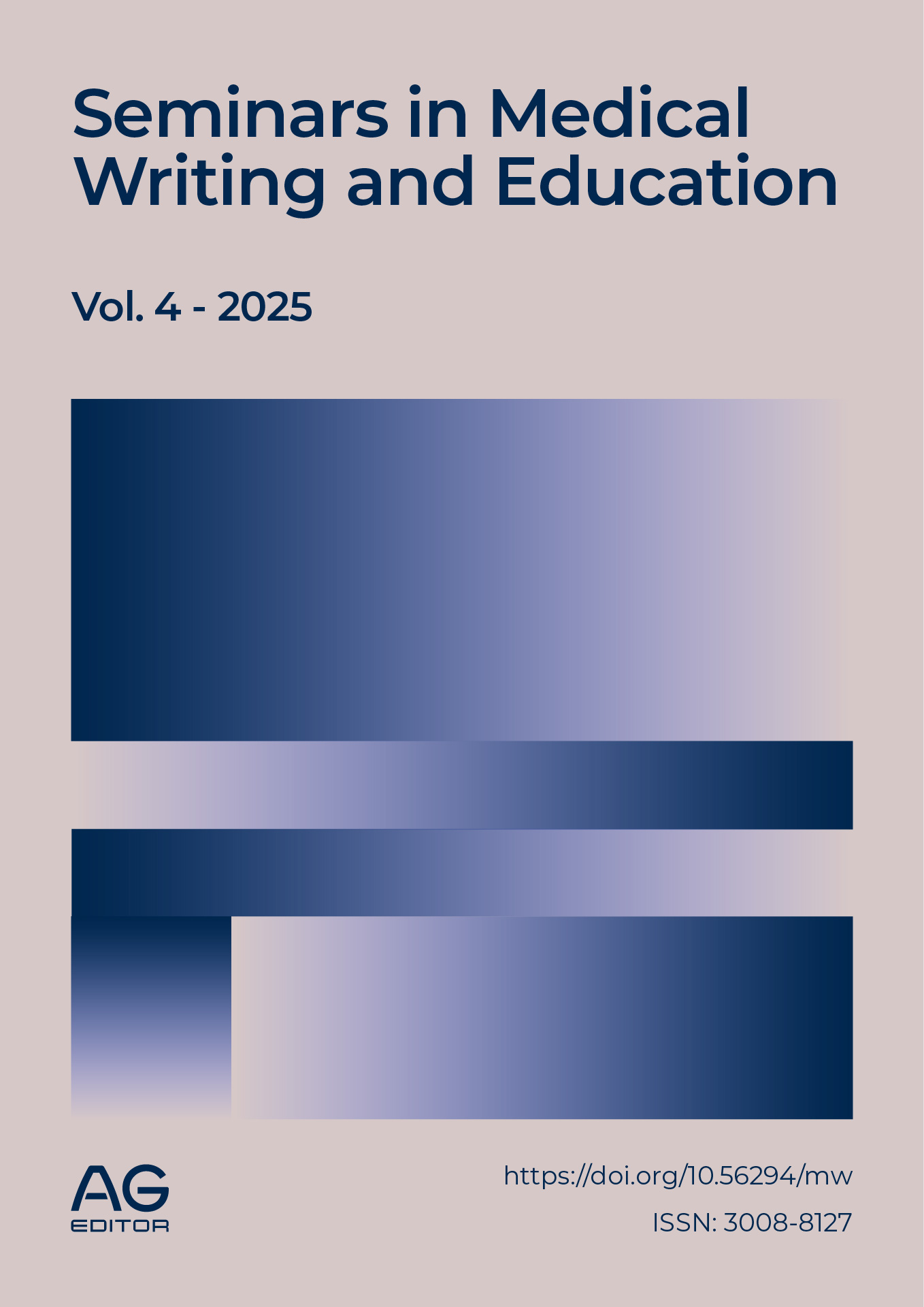Artificial Intelligence and Medicine: Where is scientific and technical development taking us?
DOI:
https://doi.org/10.56294/mw2025162Keywords:
Artificial intelligence, medicine, generative artificial intelligence, techno-scientific developmentAbstract
Introduction: Clinical reasoning is the fundamental tool in the work of the physician, and has benefited from current techno-scientific advances, which at the same time try to replace the work of the health professional. In this way, the doctor-patient relationship, the essential link in the procedures of the clinical method, deteriorates. Artificial intelligence and other innovations have revolutionized health institutions, the way of approaching medical care, clinical reasoning and the teaching-learning process of medicine. This research aims to provide a comprehensive understanding of medical reasoning inextricably linked to the techno-scientific development of society and especially to Artificial Intelligence. Results: Using Artificial Intelligence as a clinical reasoning tool facilitates the treatment of patients without replacing the role of the physician. It also explores its impact on medical decision-making and the ethical aspects of data storage. Conclusions: A comprehensive understanding of clinical reasoning inextricably linked to human social development is necessary
References
1. Benavent-Núñez D, Colomer-Mascaró J, Quecedo-Gutiérrez L, Gol-Montserrat J, del-Llano-Señarís JE. Inteligencia artificial y decisiones clínicas: Cómo está cambiando el comportamiento del médico. Editorial Fundación Gaspar Casal. [internet]. 2020 [consultado 16/10/2024]. Disponible en: https://fundaciongasparcasal.org/wp-content/uploads/2020/12/Decisiones-clinicas-e-inteligencia-artificial.pdf
2. Alejandro L. ¿Qué es el almacenamiento de datos, cómo funciona y qué tipos existen? hubsSpot. [Internet]. 2023 [consultado 16/10/2024]. Disponible en: https://blog.hubspot.es/marketing/que-es-almacenamiento-de-datos
3. Thompson I. Definición de Información Conozca cuál es la definición de información desde distintos puntos de vista. [Internet]. 2008 [consultado 16/10/2024]. Disponible en: https://www.merida.tecnm.mx/wp-content/uploads/2022/12/prueba3.pdf
4. Chiavenato I editor. Introducción a la Teoría General de la Administración 7ma ed. McGraw-Hill Interamericana. 2006. Disponible en: https://www.academia.edu/44896914/Introducci%C3%B3n_a_la_teor%C3%ADa_general_de_la_administraci%C3%B3n_7ma_edici%C3%B3n_idalberto_chiavenato
5. Morejón-Palacio JL. González-Rodríguez R. Acercamiento a la historia clínica electrónica en el contexto de la informatización en salud. Rev. Med. Electrón [internet]. 2022 [consultado 16/10/2024];44(2):403-412. Disponible en: http://scielo.sld.cu/scielo.php?script=sci_arttext&pid=S1684-18242022000200403&lng=es
6. Medicina basada en la evidencia: un nuevo reto al profesional de la información en salud. ACIMED [Internet]. 2001 [consultado 16/10/2024];9(1):5-11. Disponible en: http://scielo.sld.cu/scielo.php?script=sci_arttext&pid=S1024-94352001000100001&lng=es.
7. Santana-Pérez JL, García-Pérez RP, Álvarez-Sintes R. Ante el desafío tecnológico, defensa de la enseñanza del método clínico por asignaturas clínico-quirúrgicas. Educación Médica Superior. [Internet] 2023 [consultado 16/10/2024];37(2):e3919 Disponible en: https://pesquisa.bvsalud.org/portal/resource/en;/biblio-1528542
8. López J, María-del-Carmen-Gómez A. El razonamiento clínico con enfoque didáctico. InterCambios. Dilemas y transiciones de la Educación Superior [Internet]. 2020 [consultado 16/10/2024];7(2):16-25. Disponible en: https://doi.org/10.2916/inter.7.2.4
9. Franganillo J. La inteligencia artificial generativa y su impacto en la creación de contenidos mediáticos. Methaodos: Revista de ciencias sociales [Internet]. 2023 [consultado 16/10/2024];11(2):1-17. Disponible en: https://dialnet.unirioja.es/descarga/articulo/9132067.pdf
10. Cedeño-Cedeño YM, Pazmiño-Chancay MJ, D’Ilio-Gil HDV, Aguirre-Tello AE. Cirugía robótica, la transición de la cirugía en la actualidad. RECIAMUC [Internet]. 2022 [consultado 16/10/2024];6(2):269-7. Disponible en: https://www.reciamuc.com/index.php/RECIAMUC/article/view/862
11. Pradier SA. A propósito de Frankenstein y el autómata de san Alberto Magno… o de por qué la belleza humana no es asunto de robots. Cuadernos de Pensamiento. [Internet] 2022 [consultado 16/10/2024];35:139-166. Disponible en: https://www.redalyc.org/journal/6937/693774006005/
12. Serna ME. Desarrollo e innovación en ingeniería. 2da ed. Principios de la Inteligencia Artificial en las Ciencias Computacionales. Editorial IAI. [Internet] 2017 [consultado 16/10/2024];161-172. Disponible en: https://www.researchgate.net/publication/331498859_Principios_de_la_Inteligencia_Artificial_en_las_Ciencias_Computacionales
13. El impactante robot que inventó Leonardo Da Vinci hace 500 años: ¿cómo funciona? El cronista. [Internet] 2024. [consultado 16/10/2024]. Disponible en: https://www.cronista.com/mexico/actualidad-mx/el-impactante-robot-que-invento-leonardo-da-vinci-hace-500-anos-como-funciona/
14. Martínez-Laínez F. Leonardo, un enigma más allá de la muerte. La vanguardia. [Internet] 2019 [consultado 16/10/2024]. Disponible en: https://www.lavanguardia.com/historiayvida/edad-moderna/20190902/47311522426/leonardo-un-enigma-mas-alla-de-la-muerte.html
15. La Pascalina, la primera calculadora mecánica, inventada por Blaise Pascal en 1645. [Internet] 2021 [consultado 16/10/2024]. Disponible en: https://www.revistatransformaciondigital.com/2021/10/28/la-pascalina-la-primera-calculadora-mecanica-inventada-por-blaise-pascal-en-1645/
16. Las máquinas de Babbage. Ciencia, escepticismo y humor. [Internet] 2021 [consultado 16/10/2024]. Disponible en: https://naukas.com/2021/03/04/las-maquinas-de-babbage/
17. Siles-González I. Cibernética y sociedad de la información: el retorno de un sueño eterno. Signo y Pensamiento [Internet]. 2024 [consultado 16/10/2024];50:84-99. Disponible en: http://www.scielo.org.co/scielo.php?script=sci_arttext&pid=S0120-48232007000100007&lng=en&tlng=es.
18. Guzik-Glantz R. Relaciones de un científico mexicano con el extranjero: el caso de Arturo Rosenblueth. Rev mex inv edu [Internet]. 2009 [consultado 16/10/2024];14(40):43-67. Disponible en: http://www.scielo.org.mx/scielo.php?script=sci_arttext&pid=S1405-66662009000100004&lng=es&tlng=es.
19. Vidales C. Pasado y futuro cibernético en la teoría de la comunicación. Methaodos. Revista de ciencias sociales [Internet]. 2023 [consultado 16/10/2024]; 11(2):m231102a02. Disponible en: http://dx.doi.org/10.17502/mrcs.v11i2.614
20. Araya-Paz C. Desafíos legales de la inteligencia artificial en Chile. Rev chile derecho tecnología [Internet]. 2020 [consultado 16/10/2024];9(2):257-290. Disponible en: https://dx.doi.org/10.5354/0719-2584.2020.54489
21. Historia de la IA: John McCarthy y el lenguaje de programación LISP. Telefónica teach [Internet]. 2018 [consultado 16/10/2024]. Disponible en: https://telefonicatech.com/blog/historia-ia-john-mccarthy-lisp
22. Soto MG. Inteligencia Artificial: historia, construcción, modelos y lenguajes. Medium. [Internet]. 2024 [consultado 16/10/2024]. Disponible en: https://marvin-soto.medium.com/inteligencia-artificial-historia-construcci%C3%B3n-modelos-y-lenguajes-664c48ec4f4e
23. Padró Ll. CHATBOTS: El reto de conversar con las máquinas. Tecnology center. [Internet] 2017 [consultado 16/10/2024]. Disponible en: https://blog.cit.upc.edu/chatbots-el-reto-de-conversar-con-las-maquinas-reto-de-conversar-con-las-maquinas/
24. BBC News Mundo. La sorprendente y poco conocida historia de Eliza, el primer bot conversacional de la historia. [Internet] 2018 [consultado 16/10/2024]. Disponible en: https://www.bbc.com/mundo/noticias-44290222
25. Goldberg SB. Flemotomos N. Martinez VR. Tanana MJ. Kuo PB. Pace, BT et al. Machine learning and natural language processing in psychotherapy research: Alliance as example use case. Journal of Counseling Psychology [Internet]. 2020 [consultado 16/10/2024]:67(4):438–448. Disponible en: https://doi.org/10.1037/cou0000382
26. Bárcena ME. Traducción automática y traducción asistida por ordenador. Universidad Nacional de Educación a Distancia. [Internet] 2018 [consultado 16/10/2024]. Disponible en: https://www.researchgate.net/publication/323273904_Resumen_de_la_Traduccion_Automatica
27. El Universo Prolog. Adrianistán. [Internet] 2020 [consultado 16/10/2024]. Disponible en: https://blog.adrianistan.eu/universo-prolog/
28. Aguilar-Tarqui JR. Sistema Experto MYCIN. [Internet] 2020. [consultado 16/10/2024]:123-125. [consultado 16/10/2024]. Disponible en: http://www.revistasbolivianas.ciencia.bo/pdf/rits/n1/n1a31.pdf
29. Villa-Medina F, Gutiérrez J, Porta-Gándara MA. Vehículo robótico: autónomo y teleoperado con una PDA. Ingeniería mecánica, tecnología y desarrollo [Internet]. 2009 [consultado 16/10/2024];3(2):46-54. Disponible en: http://www.scielo.org.mx/scielo.php?script=sci_arttext&pid=S1665-73812009000100002&lng=es&tlng=es.
30. Bermejo C. 11 de mayo de 1997: el ordenador Deep Blue vence al campeón mundial de ajedrez Garri Kaspárov. El orden Mundial [Internet]. [consultado 16/10/2024]. Disponible en: https://elordenmundial.com/hoy-en-la-historia/11-mayo/11-de-mayo-de-1997-el-ordenador-deep-blue-vence-al-campeon-mundial-de-ajedrez-garri-kasparov/
31. RoboCup: The Robot World Cup Initiative [Internet]. [consultado 16/10/2024]. Disponible en: https://www2.sonycsl.co.jp/person/kitano/RoboCup/RoboCup-old.html
32. Cirett-Galán F, Torres-Peralta R. El auto inteligente: evolución e impacto social más allá de un nuevo paradigma del transporte. [Internet] 2018 [consultado 16/10/2024]. Disponible en: https://investigadores.unison.mx/ws/portalfiles/portal/6126533/31d_3.1b_RUMBO_AL_AUTO_DEL_FUTURO_Auto_Inteligente.pdf
33. Suasnabas-Pacheco LS, Carrillo-Ríos S L, Castillo-Salazar DR, Medina-Correa S M, Vásquez-Fajardo CE. Inteligencia Artificial en las Ciencias. Mawil Publicaciones de Ecuador [Internet]. 2019 [consultado 16/10/2024]. Pp:17-89. Disponible en: https://mawil.us/wp-content/uploads/2019/06/INTELIGENCIA-ARTIFICIAL-25-06-2019.pdf
34. de-Val-Pardo I. La inteligencia humana y la inteligencia artificial. Anales de Psicologia [Internet]. 2020 [consultado 16/10/2024]:186:11. Disponible en: https://www.researchgate.net/publication/360218729_La_inteligencia_humana_y_la_inteligencia_artificial
35. Devis L. Logic Theory Machine es considerado el primer programa computacional de IA. Computing. [Internet] 2023 [consultado 16/10/2024]. Disponible en: https://www.computing.es/analytics/breve-historia-de-la-inteligencia-artificial-i/
36. Basáez, Esteban, and Javier Mora. "Salud e inteligencia artificial: ¿cómo hemos evolucionado? Revista Médica Clínica Las Condes [Internet] (2022) [consultado 16/10/2024];33(6):556-561. Disponible en: https://doi.org/10.1016/j.rmclc.2022.11.003
37. Mesko B. The role of artificial intelligence in precision medicine. Expert Rev Precis Med Drug Dev [Internet]. 2017 [consultado 16/10/2024];2(5):239-41. Disponible en: https://www.tandfonline.com/doi/full/10.1080/23808993.2017.1380516
38. Auza-Santiváñez JC, Carías Díaz JA, Vedia Cruz OA, Robles-Nina SM, Sánchez Escalante C, Apaza Huanca B. Gamification in personal health management: a focus on mobile apps. Gamification and Augmented Reality [Internet]. 2024 Jan. 31 [cited 2024 Dec. 26];2:31. Available from: https://gr.ageditor.ar/index.php/gr/article/view/32
39. Suzuki K, Chen Y. 019_Artificial Intelligence in Decision Support Systems for Diagnosis in Medical Imaging. [Internet]. 2018. [consultado 16/10/2024]. Disponible en: https://books.google.dj/books/about/Artificial_Intelligence_in_Decision_Supp.html?id=vQdGDwAAQBAJ&redir_esc=y
40. Jiang F, Jiang Y, Zhi H, Dong Y, Li H, Ma S. Artificial intelligence in healthcare: Past, present and future. Stroke and Vascular Neurology. [Internet]. 2017 [consultado 16/10/2024];2(4):230-243. Disponible en: DOI: 10.1136/svn-2017-000101
41. Demner-Fushman D, Chapman WW, McDonald CJ. What can natural language processing do for clinical decision support? J Biomed Inform. [Internet]. 2009. [consultado 16/10/2024];42(5):760-72. Disponible en: doi: 10.1016/j.jbi.2009.08.007
42. Pérez-Huertas P, Edo-Solsona MD, Poveda-Andrés JL. Datos de Vida Real y Macrodatos: Su incorporación a la evaluación. Fundación Gaspar Casal [Internet]. 2018 [consultado 16/10/2024]. Disponible en: https://dialnet.unirioja.es/servlet/libro?codigo=919090
43. Dusenberry MW, Brown CK, Brewer KL. Artificial neural networks: Predicting head CT findings in elderly patients presenting with minor head injury after a fall. Am J Emerg Med. [Internet]. 2017 [consultado 16/10/2024];35(2):260-267 Disponible en: https://pubmed.ncbi.nlm.nih.gov/27876174/
44. Lee JG, Jun S, Cho YW, Lee H, Kim GB, Seo JB, et al. Deep learning in medical imaging: General overview. Korean J Radiology. [Internet]. 2017 [consultado 16/10/2024];18(4):570-584 Disponible en: doi: 10.3348/kjr.2017.18.4.570
45. Ahmadi H, Gholamzadeh M, Shahmoradi L, Nilashi M, Rashvand P. Diseases diagnosis using fuzzy logic methods: A systematic and meta-analysis ,review. Comput Methods Programs Biomed. [Internet]. 2018. [consultado 16/10/2024];161:145-172 Disponible en: https://pubmed.ncbi.nlm.nih.gov/29852957/
46. Van-der-Zant T, Kouw M, Schomaker L. Generative Artificial Intelligence. En: Müller 5th ed. Philosophy and Theory of Artificial Intelligence. Studies in Applied Philosophy, Epistemology and Rational Ethics, vol 5. 2013 [consultado 16/10/2024]. Springer, Berlin, Heidelberg. Disponible en: https://doi.org/10.1007/978-3-642-31674-6_8
47. García-Peñalvo FG, Vázquez-Ingelmo A. What do we mean by GenAI? A systematic mapping of the evolution, trends, and techniques involved in Generative AI. International Journal of Interactive. [Internet]. 2023 [consultado 16/10/2024];8(4):7-16 Disponible en: 10.9781/ijimai.2023.07.006
48. Galvani C, Horgan S. Robots en cirugía general: presente y futuro. Rev Cir Esp [Internet]. 2005 [consultado 16/10/2024];78(3):138-147. Disponible en: DOI: 10.1016/S0009-739X(05)70907-6
49. Auza-Santiváñez JC, Carías Díaz JA, Vedia Cruz OA, Robles-Nina SM, Escalante CS, Apaza Huanca B. Interactive formats: considerations for scientific publications. Seminars in Medical Writing and Education [Internet]. 2023 Nov. 7 [cited 2024 Dec. 26];2:27. Available from: https://mw.ageditor.ar/index.php/mw/article/view/28
50. Serrano-Barrera OR, Feria-Ávila H, Marcheco-Teruel B. Conocimientos sobre las tecnologías ómicas y medicina personalizada en estudiantes de Medicina. Edumecentro [Internet]. 2020 [consultado 16/10/2024]; 12(2):59-75. Disponible en: http://scielo.sld.cu/scielo.php?script=sci_arttext&pid=S2077-28742020000200059
51. Rajkumar N. Artificial intelligence-based healthcare chatbots. [Internet]. 2023 [consultado 16/10/2024]. Disponible en: https://www.linkedin.com/pulse/artificial-intelligence-based-healthcare-chatbots-rajkumar-n
52. Mina A. Big data e inteligencia artificial en el futuro manejo de pacientes. ¿Por dónde empezar? ¿En qué punto nos encontramos? ¿Quo tendimus? Adv Lab Med [Internet]. 2020 [consultado 16/10/2024];1(3):2-8. Disponible en: https://doi.org/10.1515/almed-2020-0014
Downloads
Published
Issue
Section
License
Copyright (c) 2025 Dulvis Lianet Acosta Herrería, Jorge Luis Santana Pérez, Ariel Sosa Remón, Jhossmar Cristians Auza-Santivañez , Ana Esperanza Jeréz Alvarez, Jorge Luis Santana León, Iris Ingrid Carrillo-Campos (Author)

This work is licensed under a Creative Commons Attribution 4.0 International License.
The article is distributed under the Creative Commons Attribution 4.0 License. Unless otherwise stated, associated published material is distributed under the same licence.






